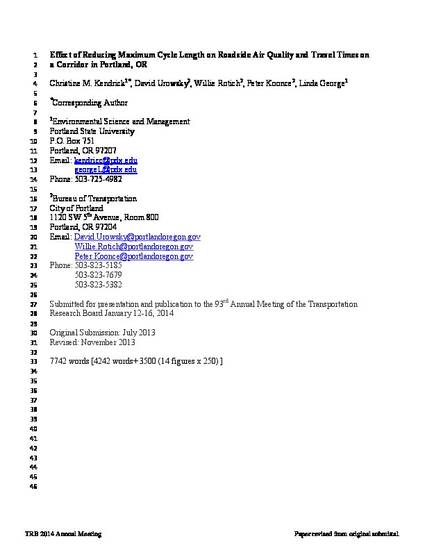
- Traffic congestion -- Environmental aspects,
- Urban transportation -- Oregon -- Portland -- Planning,
- Air -- Pollution -- Oregon -- Portland,
- Adaptive control systems
The Sydney Coordinated Adaptive Traffic System (SCATS), an adaptive signal system designed to reduce congestion, has been installed on a heavily trafficked roadway in Portland, OR. In addition to traffic performance metrics, we are investigating how this system affects roadway emissions of air pollutants. A twenty-second reduction to maximum cycle length was proposed for the SCATS system to address pedestrian delay concerns. A two-week trial period with this reduced cycle length was implemented. Travel times and roadside air pollution concentrations were monitored throughout this study period and compared to before and after periods with the current maximum cycle length. Average travel times were found to be significantly higher during the reduced maximum cycle length, but with a mean difference of only 4-5 seconds for travel time. Assessment of travel time for this roadway suggests that a twenty second decrease in maximum cycle length to help shorten pedestrian delay can be made without significant consequences to travel time. Total traffic volumes were consistent for all four weeks of the study. Meteorological conditions were similar for the first two weeks comparing maximum cycle lengths. A shift in ambient temperature led the second two weeks of the cycle length comparison to have more similar meteorological conditions versus the first two weeks. Average NO and NO2 concentrations were not significantly different for the first half of the study. However, NO and NO2 concentrations were significantly higher during the reduced maximum cycle length for the second half of the study. When there was a significant difference based on t-test statistics, the measurements did show an increase in roadside concentrations during the shorter maximum cycle length. Preliminary results are unclear if changes to air quality (as assessed by NO and NO2 concentrations) occur or not due to the reduced maximum cycle length. Results require further comparative analysis in which meteorology and traffic conditions are controlled for so that any difference in air quality due to maximum cycle length alone can be quantified.
Available at: http://works.bepress.com/linda_george/13/

Paper presented at the Transportation Research Board Proceedings, Portland, Oregon, 2014